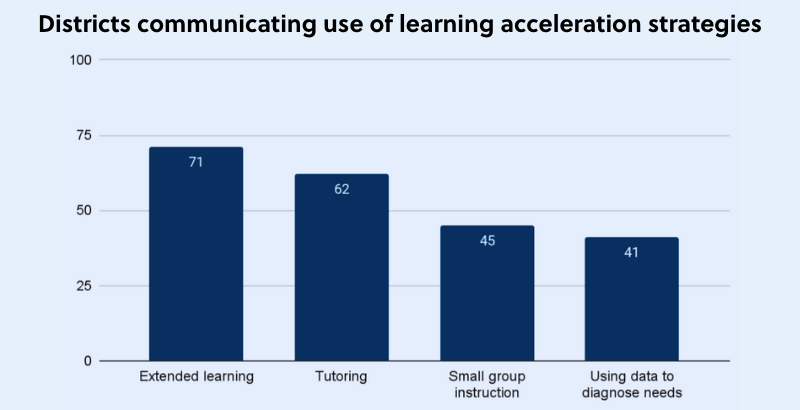By the Numbers — How 100 School Systems Are (and Aren’t) Recovering from COVID: Tutoring, Extra Class Time & Other Learning Acceleration Strategies

Get stories like this delivered straight to your inbox. Sign up for The 74 Newsletter
Learning acceleration describes efforts to expose students to engaging, grade-level content while catching them up on skills and material they might have missed.
This can be a more effective approach than remediation, in which students work their way through material below their grade level in an effort to catch up.
The Center on Reinventing Public Education’s review of pandemic responses in 100 large and urban districts finds nearly all of them are using some practices that are consistent with learning acceleration.
However, far fewer appear to have all the components of a comprehensive acceleration strategy. The most common strategies districts describe are tutoring and extended learning time, with resources given in broad strokes to grade-level groups instead of prioritized for specific students who may need targeted support to complete grade-level work.
And while districts are making academic support a focus this fall, questions of quality and sustainability still loom large. There remains little detail on new or comprehensive strategies to support special populations, or on whether extra time and resources are anchored in evidence-based approaches.
Most districts say they use at least one learning acceleration strategy this fall; fewer have all components
All but six of the districts we reviewed describe using at least one evidence-based strategy common to learning acceleration approaches, with about two-thirds of districts planning to offer tutoring or extended learning time.
Just 21 districts, including Baltimore City Public Schools, say they offer all four strategies. It has released a comprehensive “Reconnect, Restore, Reimagine” plan, which calls for all students to receive increased small-group instruction plus staff-led tutoring focused on critical literacy skills.
The district also uses diagnostic assessments, educator referrals and early warning indicators like chronic absenteeism, suspensions and failing grades to identify students who missed essential learning during the pandemic and need additional help this year.The district provides these students with extended days and tutoring, and prioritizes those with missing course credits.
Baltimore City’s plan also requires teachers to develop learning plans for every student that incorporate academic, social and emotional needs and interests. This district is also thinking beyond recovery. Its plan envisions flexible scheduling for middle and high school students, such as evening classes, virtual courses and Saturday offerings to help school better fit their lives.
Twenty-seven districts prioritize tutoring and extended learning strategies for targeted student groups. Of these, a small number focus on students with demonstrated academic need (identified through low grades or missing credits), English learners or children with disabilities. Rather than targeting students based on academic needs, districts appear to be taking broader strokes, providing resources to all students or broad, grade-level groups.
Providing academic help to broad groups can reduce stigma. If every student in a grade level has access to tutoring or small-group instruction, no one will feel singled out for receiving extra support. But it also means the students hit hardest by the pandemic could miss out on critical help, unless districts do what Baltimore has done and layer targeted support on top of broad strategies aimed at all students.
Many districts turn to tutoring, but provide few details on quality
Far more districts in our review are offering tutoring in 2021-22 (62 districts) than communicated interest in July (18 districts). The 62 districts that say they offer tutoring split nearly evenly between offering help to all interested students (24, or 39 percent of those offering tutoring) or just to targeted subgroups (22, or 35 percent). The other 16 districts do not provide information on which students will receive tutoring.
Only eight districts detail how many hours of tutoring students will receive, ranging from 1.5 to 4 per week. Similarly, few districts share how many students will receive tutoring, and in those that do, the numbers range widely — from 650 students in Boulder Valley, Colorado (2 percent of students) to over 7,000 in El Paso (13 percent). Texas districts must offer tutoring to all students under recently passed state legislation.
About half of these districts (33 of 62, or 53 percent) plan for district staff to support tutoring efforts, either alone or in combination with external tutors. Sixteen districts rely on partners like Americorps or community volunteers. Sacramento Public Schools and Kentucky’s Jefferson County Public Schools have contracted for online tutoring.
A few districts detail plans to equip tutors with evidence-based practices. In Florida’s Orange County School District, tutors are trained in a step-by-step curriculum that incorporates frequent tests to monitor student progress weekly throughout the school year. In California, Long Beach Unified tours a high-dosage tutoring model that uses iReady to assess student growth and includes services for students with disabilities and English Language Learners.
Most districts’ tutoring plans are scarce on detail about quality or adherence to evidence-based practices. The wide variation in how much tutoring districts plan to deliver, to which students and with which groups of adults also means some districts’ initiatives will likely be more effective than others — a crucial issue for researchers and state agencies to monitor in the coming months.
Districts offering students more time at school through extended learning programs
Even more districts — 71 — say they offer students extended learning time this year. Well over half of these (42) are incorporating multiple extended learning approaches.
Many districts launched extended-year programs this summer with larger and more rigorous summer school programs than in previous years.
This year, three districts lengthen the school day. Atlanta Public Schools has simply added 30 minutes to the daily schedule for elementary students. Other districts aim extended time supports to targeted students. Cobb County School District offers “vacation academies” for students selected using multiple factors like reading and math proficiency, attendance and amount of time spent learning in person versus remote. Cincinnati Public Schools’ extended learning program supports English learners and newcomers in high school at risk of drop out, and works with outside partners.
A few other districts use weekends and holidays. Fort Worth Independent School District’s Saturday Learning Quest program provides 14 additional instructional days on Saturday, targeted to students in grades 1 to 3 in the lower quartile for math and literacy. The program offers social emotional learning and parent education, and it monitors students’ progress on both academics and well-being using NWEA surveys.
Districts must invest in staff and partners to ensure supports translate into student success
Details are getting clearer on how large and urban districts plan to address disruptions to learning and student well-being since March 2020.
Many of these approaches ask school staff to lead new strategies — such as targeting teaching to specific students — or to incorporate standard best practices into their daily efforts, such as small-group instruction and use of data to determine what support each child needs. Some districts are leaning on community partners to provide more support than the district alone can provide.
Very few districts, however, name students with disabilities or English learners as their priority for new targeted supports. That means these students, who were often overlooked or inadequately supported during remote learning, are still at risk of missing out on critical aid during pandemic recovery.
How effectively these strategies support learning and recovery for all students will depend on the quality of execution and coordination across schools and districts. Some districts allude to evidence-based practices, but generally it is not clear what methodology they are using to design programs and what supports they are providing adults to ensure consistent quality.
Teachers, paraeducators, counselors and mental health support staff need quality training and planning time to create the coherence needed to accelerate student learning.
Federal emergency relief funds, which drive many of these learning acceleration investments, will dry up in a few years. Districts that invest in the quality and capacity of their staff to lead effective and more student-centered interventions will see lasting returns, but others risk squandering a critical opportunity.
Bree Dusseault is principal at the Center on Reinventing Public Education, supporting its analysis of district and charter responses to COVID-19. She previously served as executive director of Green Dot Public Schools Washington, executive director of pK-12 schools for Seattle Public Schools, a researcher at CRPE, and as a principal and teacher.
Get stories like these delivered straight to your inbox. Sign up for The 74 Newsletter

;)
